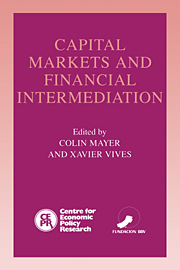Book contents
- Frontmatter
- Contents
- List of figures
- List of tables
- Preface
- List of conference participants
- 1 Introduction
- 2 Efficient governance structure: implications for banking regulation
- Discussion
- 3 Bank loan maturity and priority when borrowers can refinance
- Discussion
- 4 Stock markets and resource allocation
- Discussion
- 5 Informational capacity and financial collapse
- Discussion
- 6 Financial intermediation and economic development
- Discussion
- 7 Creditor passivity and bankruptcy: implications for economic reform
- Discussion
- 8 Enterprise debt and economic transformation: financial restructuring in Central and Eastern Europe
- Discussion
- 9 Bank regulation, reputation and rents: theory and policy implications
- Discussion
- 10 Relationship banking, deposit insurance and bank portfolio choice
- Discussion
- 11 Competition and bank performance: a theoretical perspective
- Discussion
- Index
Discussion
Published online by Cambridge University Press: 04 August 2010
- Frontmatter
- Contents
- List of figures
- List of tables
- Preface
- List of conference participants
- 1 Introduction
- 2 Efficient governance structure: implications for banking regulation
- Discussion
- 3 Bank loan maturity and priority when borrowers can refinance
- Discussion
- 4 Stock markets and resource allocation
- Discussion
- 5 Informational capacity and financial collapse
- Discussion
- 6 Financial intermediation and economic development
- Discussion
- 7 Creditor passivity and bankruptcy: implications for economic reform
- Discussion
- 8 Enterprise debt and economic transformation: financial restructuring in Central and Eastern Europe
- Discussion
- 9 Bank regulation, reputation and rents: theory and policy implications
- Discussion
- 10 Relationship banking, deposit insurance and bank portfolio choice
- Discussion
- 11 Competition and bank performance: a theoretical perspective
- Discussion
- Index
Summary
This paper contributes to a recent literature concerned with optimal debt structure. Until very recently corporate finance theorists have mostly been concerned with agency theories or control theories of the optimal choice of debt/equity ratio. These theories do not differentiate between different forms of debt. Typically, only one form of debt instrument is considered. In practice, however, firms' liabilities are composed of many different forms of debt held by different lenders. The larger firms (e.g. Fortune 500 firms) have liabilities in the form of bank debt, trade credit, bonds (which may be callable, convertible and what not). Given this observed diversity of debt instruments and given the importance of debt financing (over 80 per cent of firms' external funding in the US in the last decade was in the form of debt), the recent literature concerned with optimal debt structure fills an important gap in the theory of corporate finance.
The specific aspect of debt structure which Diamond is concerned with here and in previous research is how the firm's liabilities can be designed so as to use future information about the firm's creditworthiness efficiently. His approach to this problem is similar to that taken in the recent literature on vertical restraints (see Tirole, 1988): he begins by characterizing the optimal principal/agent contract with full commitment and then asks how this contract can be replicated with a combination of standard debt contracts of differing maturities and a given priority rule.
- Type
- Chapter
- Information
- Capital Markets and Financial Intermediation , pp. 68 - 80Publisher: Cambridge University PressPrint publication year: 1993



